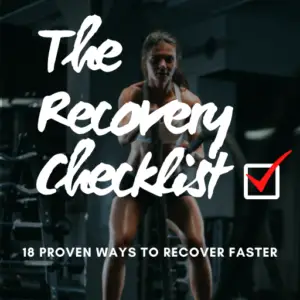Crash! The barbell slammed to the gym floor.
Pain shot through my lower back. I had just deadlifted 335 lbs for 4 repetitions, a new PR (personal record). My back muscles squeezed tight like a boa constrictor as I hobbled back to my college dorm.
Lower back pain after deadlifts is a rite of passage for lifters. The deadlift, the “king of the lifts,” has caused more sore backs than any other exercise.

There are 4 common causes of back pain after deadlifts:
1) Too Much, Too Soon
Deadlifts are fun because it’s exhilarating to lift heavy weights!
Deadlifts strengthen the lower body and beef up the entire posterior chain. They train major muscle groups like the hamstrings, glutes, erector spinae (low back muscles) and upper back muscles.

Plus, deadlifting is a natural movement. From a young age, we pick stuff up from the floor. That’s what a deadlift is.
But some people lift too heavy, too early and hurt themselves. They let their egos dictate the workout program, instead of their brains.
Here’s how it happens: After 3 months away from the gym, a lifter goes all-out the first session back. We’re talking heavy weights and more sets than Djokovic won at Wimbledon.
A lot of my physical therapy patients see me because they ramped up their exercise routine too fast. Many people get injured early in the year thanks to overly ambitious New Year’s resolutions. It also happened in 2020 when people returned to the gym after months of gym closures.
The human body has an amazing ability to adapt and recover.
But it needs time. A non-runner will get hurt trying to run a marathon without training. But with 1-2 years of consistent training, they’re destined to cross the finish line.
The same principles apply to the deadlift. It’s important to let your body adapt to deadlifts before slapping stacks of 45s on the bar and attempting a 1-rep-maximum. Practice great form with lower weights and gradually add weight to the bar.
It’s like forming any other habit–start small, be consistent, and improve incrementally. It’s based on the principles outlined James Clear’s best-selling book, Atomic Habits.
Want to start doing cardio? Check out my suggestions for building a cardio habit from scratch.
2) Flexion-Sensitive Low Back Pain
About 60% of people with low back pain are sensitive to flexion (forward bending) and feel better with extension exercises (1).
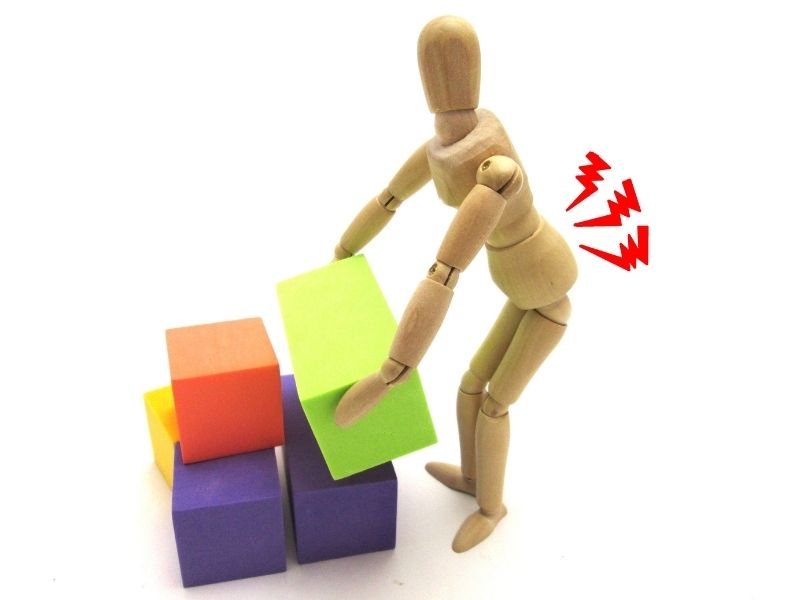
Patients who respond to back extensions typically experience pain after repeated or sustained flexion activity–like lifting boxes, pulling weeds, or sitting in the car for several hours. And of course, deadlifting.
The McKenzie Method is built to relieve flexion-sensitive back pain. This approach uses repeated motions to relieve pain. Repeated extensions (below) alleviate pain related to bending forward or deadlifting.
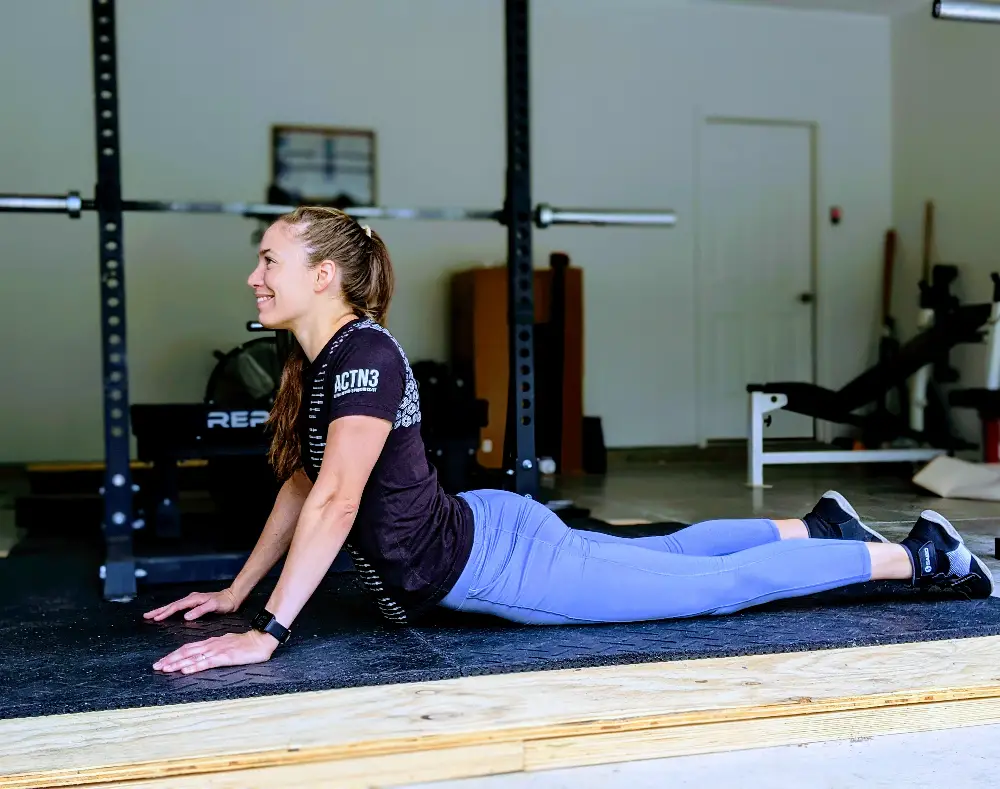
It’s how one of my college athletes overcame back pain from deadlifting. He rapidly returned to training hard and tackling opponents.
To learn more about the McKenzie Method, check out Treat Your Own Back, a resource that helped me take control of my back pain and deadlift pain-free.
When I hurt my back deadlifting in college, I didn’t know what to do. I went to the school’s training room and got poor treatment that prolonged my recovery.
A few years later, I hurt my back again deadlifting. Another set of 4 reps did me in (this time with 515 lbs). I’d been finished my doctorate in physical therapy, so I knew what to do. I used McKenzie exercises to relieve pain and returned to deadlifting within 2 weeks.
3) Muscle Soreness
Deadlifts train the low back muscles hard. After a tough training session, it’s normal to have sore muscles the next day. If you’re not a little sore, did you even lift?!

Just like you hobble around on sore legs after a taxing leg day, lower back soreness is typical after deadlifts. Normal delayed onset muscle soreness (DOMS) occurs 24 to 48 hours after a training session.
Lower back soreness that lasts 4+ days after a workout indicates the session was too difficult or you’re not recovering well. It can also mean you’re dealing with a lower back problem instead of normal soreness.
4) Bad Form
Even if “Insta-experts” claim otherwise, form does matter. Good form optimizes biomechanics and efficiency. Poor form makes the lift harder and places more stress on the lower back.
Improper form doesn’t mean injury is a foregone conclusion. Just like eating two-week-old sushi from a gas station doesn’t mean you’ll get food poisoning. But are those risks you really want to take?
These 3 deadlift technique flaws can contribute to low back pain:
A) Excessive Low Back Rounding
Lumbar spine flexion (forward bending) is an unavoidable part of deadlifting, even if the spine looks flat.
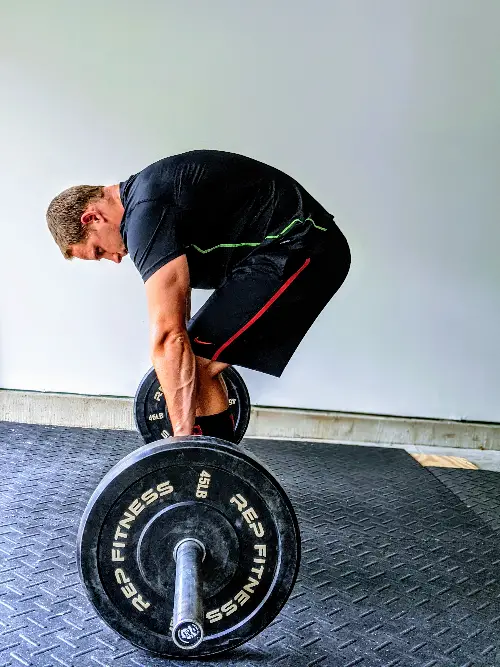
But lifting with the low back in a rounded position puts more strain on the low back muscles and makes the top portion of the lift (lockout) tougher.
Aim for a flat back position during deadlifts. But don’t lose sleep if your back rounds a little with near-maximal weights.
B) Hips Shooting Up
Lifters who “squat their deadlift” make this mistake. It’s evident once the weight gets heavy.
The set-up looks beautiful. But don’t be fooled. The hips are too low. There’s zero tension in the hamstrings.
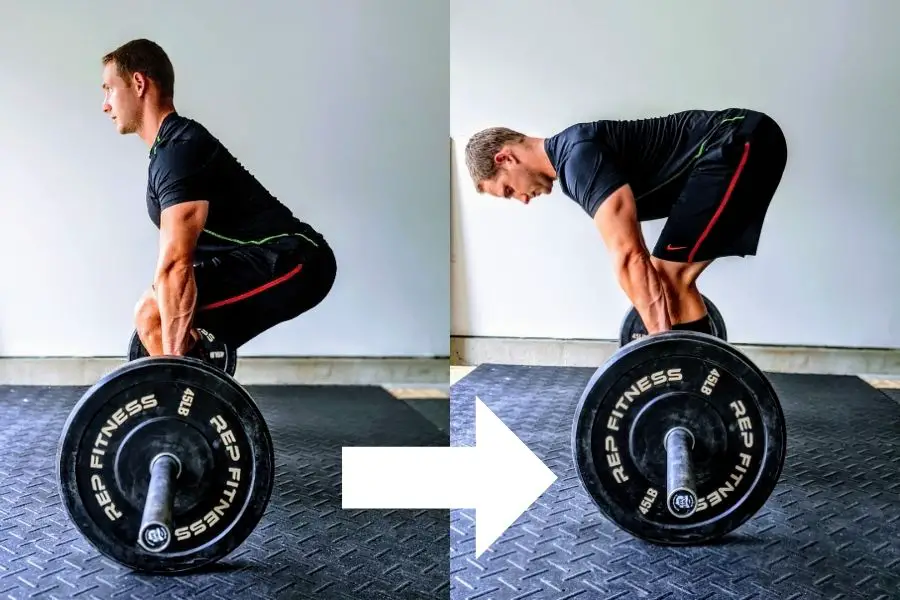
As a lifter tries to pull a bar off the floor, the hips shoot up and the knees straighten. This technique fault creates inefficiency and torques the lower back.
The solution is a bit counter-intuitive. Change the starting position–begin the lift with your hips higher. Find tension through the hamstrings before pulling the bar off the ground. The trunk angle should stay the same as the barbell leaves the floor.
In other words, the hips and shoulders should rise at the same rate during the early part of the lift. This is easiest to view from the side.
Pro Tip: Video your lifts for unbiased feedback.
C) Jerking Into the Bar
Pulling 100% force into the bar from a position of zero tension rapidly loads the hamstrings and low back–not ideal. For more consistent positioning off the floor, “pull the slack out of the bar.” To do this, smoothly increase tension into the bar as you pull it off floor.
Why You Should Deadlift
The low back muscles work extremely hard during the deadlift. That’s a good thing! It makes the low back more durable and less prone to injury during daily lifting activities.
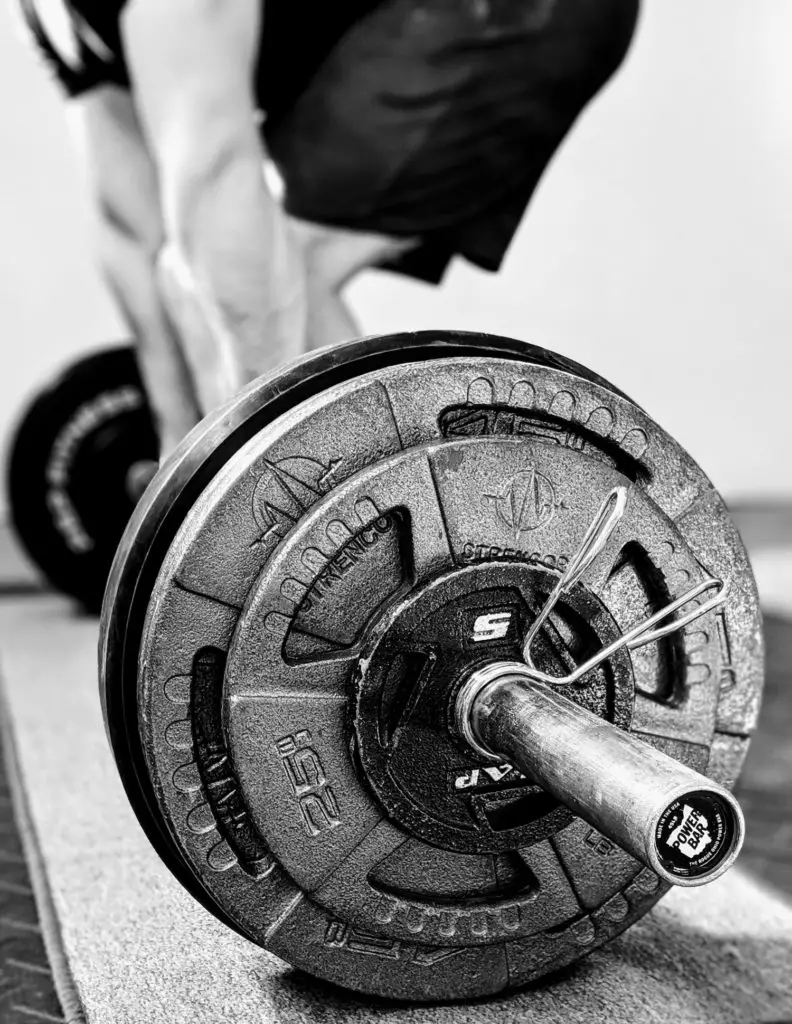
Imagine a beefy lifter who can deadlift 700 lb. Next to him stands a scrawny weakling who can barely lift 12 lbs off the floor. If they both have a job that requires lifting a 10 lb box over and over again, which one is more likely to get hurt at work?
The scrawny one of course! Deadlifts build strong leg, hip, and back muscles that fortify us against the physical demands of life. Plus, it’s one of the best exercises for adding muscle mass.
5 Solutions for Low Back Pain
Let’s get to a few actionable tips. These 5 strategies can alleviate lower back pain from deadlifts:
1) Don’t Panic
Low back pain is not a serious medical problem over 99% of the time (2). It typically heals on its own. Panicking is a classic low back pain mistake that delays recovery.
2) See a Physical Therapist
Physical therapy is a great option for lower back pain. Starting with PT results in lower costs and better outcomes than seeing a primary care doctor or a specialist first (3). It’s a good idea to seek individual medical advice if your symptoms include muscle spasms or sharp lower back pain.
Nerve pain (or sciatica) is another clear sign you should seek medical attention. Physical therapy usually relieves sciatica. But like a sprained ankle it’s nothing to play with.
Most states allow direct access, which means you can go to physical therapy without a doctor’s order. Check with your insurance provider, since they may require a physician’s referral to PT.
3) Try Repeated Movements
Repeated lumbar extensions can work wonders for lower back pain from deadlifts. This book allowed me to take control of my back pain and deadlift over 650 lbs (results may vary).
4) Improve Your Programming
The YOLO approach doesn’t work for deadlifts. It won’t get you anywhere, except sent to physical therapy.
If your back pain gets worse when you lift heavier weight, or high volume sessions glue you to the couch for a couple days, your programming needs help.

Find a coach or an experienced lifter to show you the ropes and teach you how to get stronger without getting hurt. Or learn more about programming with The Muscle and Strength Pyramid.
5) Optimize Your Technique
Bad deadlift form will stall your progress and may lead to injury. I videoed hundreds of my own deadlifts and nitpicked my technique until I got it right.
If your form suffers from any of the 3 common faults mentioned above, you’re not getting the most out of your training.
Deadlift Exercise Progression
If you’re new to deadlifting, or coming off an injury, these exercises will prepare your body for heavy deadlifts and new PRs in the coming months. They’re listed from easiest to hardest. Start at the beginning of the list. Progress to the harder variations as technique and pain improve.
Hip Hinge
Hinging at the hips is foundational to good deadlift technique. Here’s how to practice:
Keep your back flat straight and push your butt backwards. Fold forward at your hips. The knees stay slightly bent.
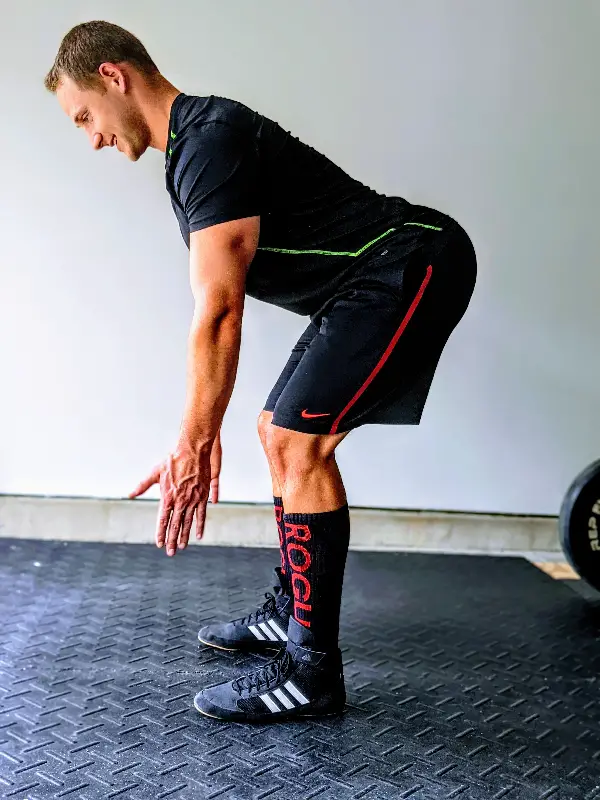
Practice this motor pattern often to improve your deadlift techinque.
Here’s an easy cue I give patients to practice: Imagine you’re holding 5 grocery bags in each hand. You need to close the car door behind you, but your hands are full. Stick your hips back to push the door closed. That’s a hip hinge!
Deadlift From a Box
Once you master the hip hinge, practice your technique with a light load–use a kettlebell or dumbbell. Elevate the weight on a box, bumper plate, or step to make it easier.
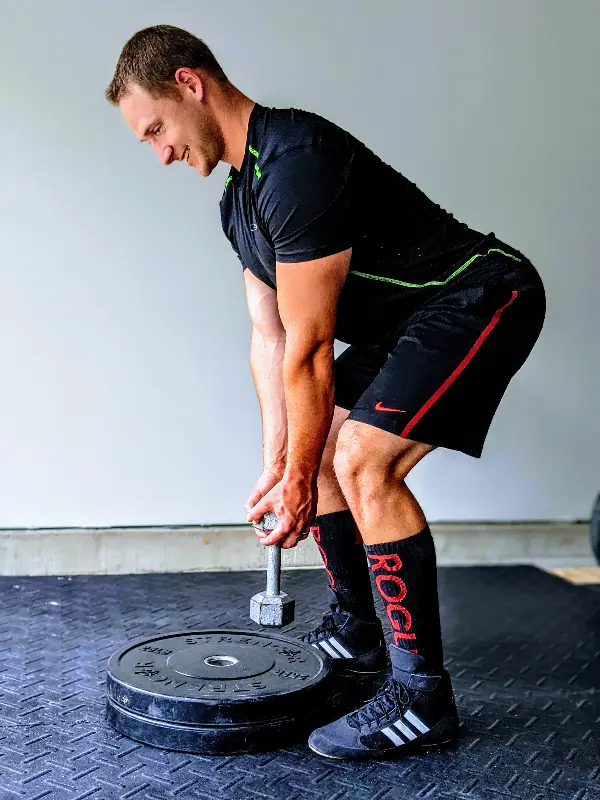
Many people aren’t mobile enough to lift a weight from the floor with good deadlift technique. Practice the hip hinge pattern to improve your mobility and motor control. It’s a better approach than stretching.
Block Pulls or Rack Pulls
A block or rack pull is a deadlift from an elevated surface. Keep the load light and master your hip hinge. For extra credit, video yourself from the side to visualize your impeccable technique.
Barbell Deadlift
Last but not least, the conventional deadlift.

Start light, master your technique, and gradually add weight and repetitions as you get stronger.
My Deadlifting Saga
In the end, I didn’t give up on deadlifts. I learned from my injuries and optimized my technique. I even switched to sumo deadlifts because it made sense for my anatomy.
Since injuring my back with 335 lb deadlifts in college, my strength has skyrocketed. To date, my best deadlift in the gym is 690 lbs. In competition, I’ve pulled 661 lbs, or 300kg.
Deadlifts make my back stronger and more injury resistant. They can do the same for you.
For more tips on getting healthier and beating pain, sign up for my free weekly newsletter.

